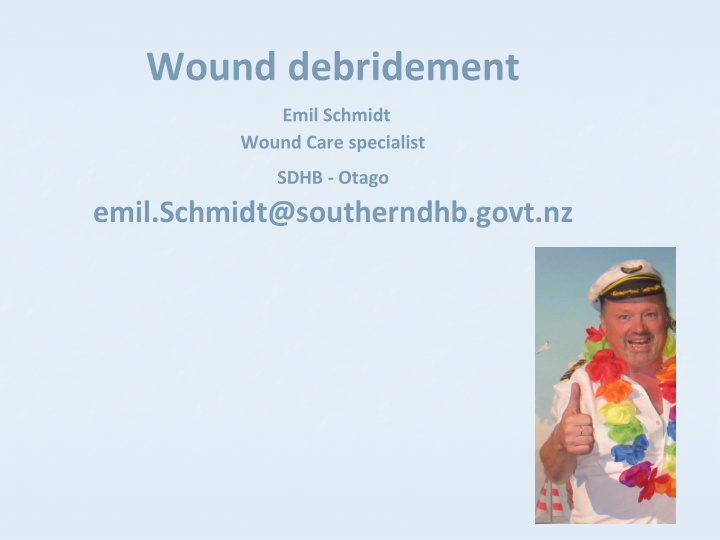



Wound debridement Emil Schmidt Wound Care specialist SDHB - Otago emil.Schmidt@southerndhb.govt.nz
You need to talk about Biofilms
Biofilms Biopsies from chronic wounds show that 60% of the specimens contained biofilm structures [8].
Biofilms
Treatment of biofilms on teeth?
How do you treat biofilms on wounds? What would you do?
EWMA Document: Principle Role of Debridement
Debridement ◼ Frequency of Debridement's and Time to Heal: A retrospective Cohort study of 312,744 Wounds JAMA Dermatology July Page 1-8 (Wilcox, et.al.,2013) The more frequent the debridement’s, the better the healing outcome ◼ Diabetic foot wounds that were debrided over 12 weeks had a 5.3 times greater chance of healing (Armstrong, 2011)
Cleansing is not debridement ◼ Cleansing with water/saline defined as the removal of dirt (loose metabolic waste or foreign material)
Definition of Debridement ◼ removes adherent, dead or contaminated tissue from a wound ◼ Including wound edges and the peri- wound skin
Debridement removes ◼ Exudate ◼ Slough ◼ Serocrusts ◼ Hyperkeratosis ◼ Necrosis ◼ Pus ◼ Haematomas ◼ Foreign bodies ◼ Debris ◼ Bone fragments
Benefits of Debridement Decrease Stimulate ◼ Odour ◼ Wound edges ◼ Excess moisture ◼ Epithelialisation ◼ Risk of infection ◼ Wound healing ◼ Bacterial burden ◼ Pain ◼ Biofilm Improve ◼ normalises biochemistry e.g. normalising the matrix metalloproteinase (MMP) and TIMP balance ◼ Quality of life
Parameters influencing the decision for debridement and the choice of technique ◼ Pain ◼ Skill of the care giver ◼ Patients environment ◼ Resources of the care giver ◼ Patients choice and consent ◼ Regulations ◼ co-morbidities ◼ Local Guidelines ◼ Quality and stage of life
Patient consent for debridement ◼ Patient fear ◼ Any procedure should be thoroughly explained to the patient ◼ The patient should be forewarned about any manipulations (injection, tracking of tissue, application of the tourniquet) ◼ Pain is a very important issue in the treatment of wounds ◼ Appropriate anesthesia is essential in all types of debridement ◼ Some wounds are painless for example diabetic foot ulcers neuropathy, frostbite
Adequate Pain management Topical ◼ EMLA 5 % ◼ Lignocaine 2 % Gel ◼ Morphine tincture 9 ml hydrogel/10mg Morphine Systemic ◼ Fentanyl patches ◼ Entonox gas ◼ IV ◼ Nerve blocks
Indications for debridement Define the problem (necrosis, eschar, 1. slough, sources of infection) Define the exudate levels of the wound 2. bed ranging from dry to wet Diagnosis of different kinds of tissue 3. types and bioburden which cover the wound bed, the state of the wound edges and the peri-wound skin
Have a plan • Define an aim • Define a timeframe • Define a method Wound Characteristic • Available skills • Available resources
EWMA Document: Principle Role of Debridement
Debridement – integrated management plan Debridement is an integrated part of the management of a person with a wound, achieving certain goals and therefore creating a healthy wound bed, edges and peri-wound skin, with the objective of promoting and accelerating healing
Debridement Quality cycle www.ewma.com
Methods of Debridement ◼ Mechanical ◼ Autolytic ◼ Enzymatic ◼ Larval ◼ Ultrasound ◼ Sharp ◼ Surgical
Mechanical Debridement ◼ Mechanical wound debridement involves the use of dry gauze dressings or wet to dry gauze dressings to remove non-viable tissue from the wound bed
Limitations ◼ Gauze as a debridement agent is associated with significantly more pain for ◼ Frequent dressing changes to avoid pain ◼ The use of wet-to-dry, plain gauze and paraffin tulle as debriding agents has little to support their use
Monofilament pads ◼ Mono filament pads e.g. Debrisoft ◼ Can be quick and effective ◼ Less pain removes debris and exudate from wounds
Autolytic debridement ◼ Moist interactive wound dressings ◼ Hydrocolloids ◼ Hydrogels ◼ Occlusive dressing ◼ Semi-occlusive dressing ◼ Facilitates healing
Indications Autolytic dressings are indicated for wounds with necrotic tissue or fibrin coatings to rehydrate, soften and liquefy hard eschar and slough
Remember…. ◼ Moist interactive dressings not always appropriate ◼ If there is no blood supply keep it dry ◼ Unless you are 100% sure there is viable tissue beneath or you have been advised by a WCNS or responsible physician
Wet slough
Compression!
Local infection
Wound Irrigation solution and gels containing antimicrobials • Cleansing, rinsing and decontamination of acute and chronic skin wounds • Helpful in the prevention of biofilm
Acetic Acid (Vinegar) soak • 1 part of 5 % vinegar and 9 part saline/water = 0.5 % • Soak gauze and leave on wound for 10 minutes • Wash off mixture • Continue with dressing plan • Repeat daily for 5-7 days • Especially beneficial against Pseudomonas aeruginosa The solution to the pollution is in the dilution
Recommend
More recommend